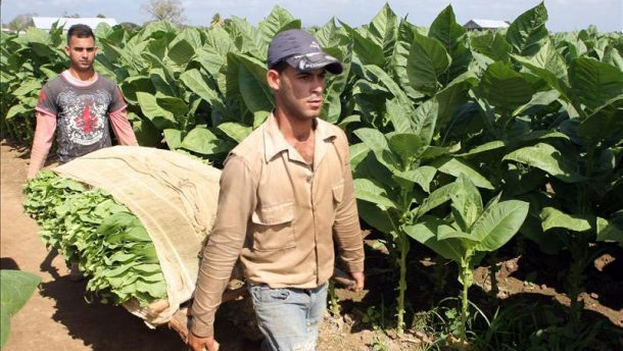
![]() 14ymedio, Havana, 23 March 2023 — Pinar del Río has not produced even half the tobacco that was planned. The main Cuban export will now have, without a doubt, what the official newspaper Granma describes as “the smallest [harvest] in history” in an area that produces between 60% and 70% of the national production.
14ymedio, Havana, 23 March 2023 — Pinar del Río has not produced even half the tobacco that was planned. The main Cuban export will now have, without a doubt, what the official newspaper Granma describes as “the smallest [harvest] in history” in an area that produces between 60% and 70% of the national production.
While 27,675 acres were planned for planting in Vueltabajo, the total barely reached 12,730, or 46%, and there are just days left to finish this step.
As a consequence of the disaster, of the 4,556 farmers who were going to start planting only 3,456 have done so, while some 1,100 have not, and the number is not expected to increase.
Osvaldo Santana Vera, coordinator of the Tabacuba group in Vueltabajo, explained to the official newspaper Granma that the plan has been readjusted twice since the impact of Hurricane Ian last September destroyed 90% of the province’s tobacco drying sheds, more than 10,000 of the total 12,000.
“Given the impossibility of rebuilding them all again in a matter of a few months, in time to protect the leaves of the current harvest, the Tabacuba Business Group decided to prioritize the highest quality plantings to ensure export demands,” the article explains.
But even so, it has not been possible to salvage the situation, and the lack of wood has had repercussions. Of the 3,977 curing sheds that are needed, and with readjustments based on the planting, more than 1,400 still need to be built.
All this led to a reduction of the plan to 15,793 acres, but that amount was excessive, so it was reduced again to 14,275 acres, extending the plan by 50 days. The figure is still remarkably far from what is needed.
To this must be added the farmers who have refused to sow because the State still owes them money, according to 14ymedio sources in San Juan and Martínez. Tobacco producers in the province told this newspaper that there have been several meetings to try to convince the farmers to plant by stating that the payment would be made as soon as possible, but many are suspicious and have reverted to the cultivation of flowers, peanuts and fruits of shorter cycles or that need fewer resources.
Granma’s version, however, attributes the crisis of the sector to the climate and the “demolishing blow that nature dealt” to the producers, and the article ends with a call for epic resistance, although they will have to wait another year. “The men and women who produce the best tobacco in the world claim that this is just a skirmish (…) and say that another cock will crow in the next harvest.”
The passage of the hurricane and the destruction of the drying sheds meant that tons of tobacco leaves had to be sent to other provinces to try to safeguard them. About 6,000 tons were transferred to Matanzas, Sancti Spíritus, Villa Clara and Cienfuegos, in addition to “about 11,000” that were already in the dryers and, after getting wet from the rain, had to undergo a new process or be discarded.
Just a week ago, a dryer in Jovellanos, Matanzas burned more than 11,300 bundles of freshly harvested tobacco. The firefighters were able to put out the fire and prevent it from spreading, but the loss is one more nail in the coffin of the sector.
Translated by Regina Anavy
____________
COLLABORATE WITH OUR WORK: The 14ymedio team is committed to practicing serious journalism that reflects Cuba’s reality in all its depth. Thank you for joining us on this long journey. We invite you to continue supporting us by becoming a member of 14ymedio now. Together we can continue transforming journalism in Cuba.
